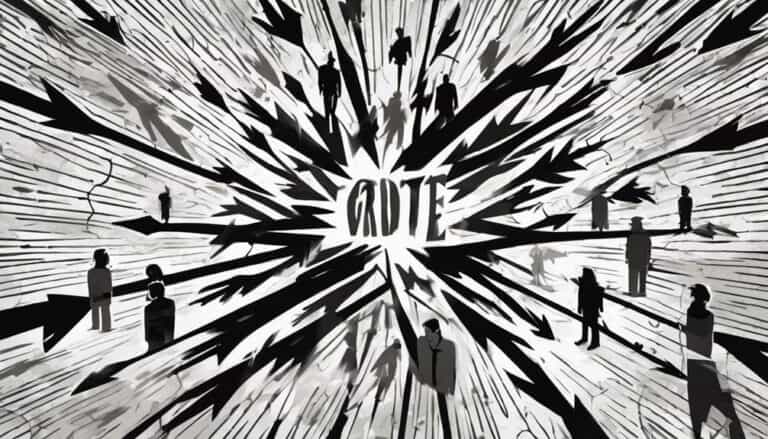Imagine constructing a house using only a single tool, like a hammer. While the hammer is important for certain tasks, relying solely on it may limit your ability to tackle the project effectively.
Similarly, decision-making frameworks, while providing structure and guidance, have their limitations. They might not always adapt to unique circumstances or incorporate nuanced human elements vital for sound decision-making.
As you consider the potential drawbacks of these frameworks, it's essential to explore how they interact with real-world complexities and the human factor in decision-making processes.
Key Takeaways
- Lack of flexibility hinders adaptability and stifles creativity in decision-making.
- Overemphasis on process may impede reaching desired outcomes effectively.
- Information overload can lead to cognitive burden, inefficiency, and errors.
- Resistance to change limits evolution and innovation, hindering organizational adaptation and growth.
Lack of Flexibility in Decision-Making
In decision-making, a lack of flexibility can impede adaptability to changing circumstances, stifling creativity and hindering organizational agility. When decisions are made within rigid frameworks, the room for exploring innovative solutions diminishes. Creativity thrives on the ability to think outside the box, but rigidity in decision-making processes can confine creativity to established norms. Without the freedom to innovate, organizations may struggle to keep up with evolving market conditions and miss valuable opportunities for growth.
The consequences of inflexible decision-making extend beyond missed chances for improvement; they can also impede organizational adaptation to dynamic environments. In today's fast-paced business landscape, agility is key to seizing emerging opportunities and voyaging unexpected challenges. Decision-making frameworks that lack flexibility may hinder a company's ability to pivot swiftly in response to market shifts. By fostering adaptability and encouraging creative problem-solving, organizations can better position themselves to thrive amidst changing conditions.
Overemphasis on Process Vs. Results
Excessive focus on the decision-making process over actual results can hinder organizational effectiveness and impede adaptability to changing circumstances. While it's important to have a structured framework for decision-making, solely prioritizing the process without achieving impactful results can lead to drawbacks. In doing so, there's a risk of delays in reaching desired outcomes and a potential lack of adaptability when faced with dynamic situations.
It's essential to strike a balance between adhering to the decision-making process and focusing on delivering effective results promptly. Rigidly following the framework without considering real-time feedback may restrict the ability to make timely and impactful decisions, thereby affecting decision-making effectiveness.
To mitigate these drawbacks, organizations should emphasize not only the process but also the outcomes, ensuring that the framework supports the timely delivery of effective decisions while remaining adaptable to changing circumstances. Balancing framework adherence with achieving desired results is key to maximizing decision-making effectiveness and organizational success.
Potential for Information Overload
The risk of overwhelming decision-makers with excessive information looms as a significant challenge within decision-making frameworks. When faced with information overload, several negative consequences can arise, affecting the quality of decisions and overall efficiency:
- Cognitive Overload: Too much information can lead to cognitive overload, making it difficult for decision-makers to process and analyze data effectively.
- Inefficiency: Excessive information can cause delays in the decision-making process, reducing efficiency and potentially resulting in missed deadlines.
- Decision Fatigue: Information overload may contribute to decision fatigue, prompting rushed or suboptimal choices without thorough data analysis.
- Errors and Overlooking Details: Overloading decision-makers with information increases the likelihood of errors, inaccuracies, and overlooking crucial details in the decision-making process.
To mitigate these risks, it's vital to find a balance in the amount of information provided in decision-making frameworks. Ensuring that decision-makers have access to relevant and necessary data can lead to well-informed and strategic decisions.
Resistance to Change and Innovation
Resistance to change and innovation poses a significant barrier to the evolution and advancement of decision-making frameworks in organizations. When employees resist new ideas or processes, it can impede the organization's ability to adapt and thrive in a rapidly changing environment. This resistance may stem from fear of the unknown, disruption of routines, or a lack of understanding about the benefits that innovation can bring. Additionally, without buy-in from key stakeholders and leadership, overcoming resistance to change becomes even more challenging.
Organizational culture plays an important role in either fostering or inhibiting innovation. Cultures that are averse to change can thwart the successful implementation of new decision-making frameworks. To address resistance, effective communication is paramount. Engaging stakeholders, clearly articulating the advantages of innovation, and demonstrating how it aligns with organizational goals are essential steps in driving adoption.
To successfully navigate resistance to change and foster innovation within an organization, leaders must champion a culture that embraces adaptability, communicates effectively, and highlights the benefits of adopting new decision-making approaches.
Risk of Ignoring Intuition and Creativity
By neglecting intuition and creativity within decision-making frameworks, organizations risk overlooking valuable insights and limiting innovative solutions that could provide a competitive edge. Here's why it's important to balance rational analysis with intuition and creativity:
- Overlooking Valuable Insights: Ignoring intuition means dismissing potentially important information that may not be apparent through data-driven processes alone.
- Limiting Innovative Solutions: Creativity is the fuel for out-of-the-box thinking, and a framework devoid of it can stifle the generation of groundbreaking solutions.
- Missed Opportunities: Intuition can offer quicker, instinctual responses that complement rational analysis, aiding in seizing opportunities promptly.
- Lack of Competitive Edge: Failure to incorporate intuition and creativity may result in solutions that lack the competitive edge needed in today's dynamic business landscape.
Conclusion
You thought decision-making frameworks were supposed to make your life easier, but turns out they can actually make things more complicated. Who knew that trying to streamline the decision-making process could end up causing more problems?
Maybe next time, you'll trust your gut instinct and creativity instead of relying too heavily on a rigid framework. Life is full of surprises, isn't it?

